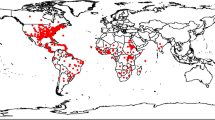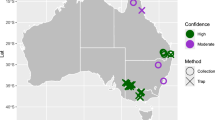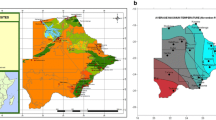Abstract
Invasive pest species can represent significant losses to the agricultural economy of a country. Assessing the potential distribution of known pest species could be an important tool to evaluate possible invasive threats globally. Agrotis robusta (Blanchard) is an endemic species of temperate areas of South America considered an important pest of seedlings of sunflower, dry bean, and potatoes. The polyphagous habit of A. robusta, along with its regional importance and history of misidentifications, makes it a species of concern for other regions of the world. In this work, we assessed the potential distribution of A. robusta with Maxent based on occurrence data and variables related to climate and soil. The bioclimate profile of the species showed a marked seasonality and medium average monthly temperature, coinciding with the temperate climate of the Köppen-Geiger classification. Other important variables related to the species distribution included average solar radiation and soil pH. Suitable conditions were identified in North America, Central America, Europe, Southern Africa, Asia, and Australia. High suitable places overlapped with some of the most important countries of production of host crops of A. robusta. Our conclusions highlight the importance of taking this species into account when importing goods from countries with the presence of A. robusta, especially for countries that are important producers of host crops.





Similar content being viewed by others
Availability of data and material
All data and materials as well as software application support our published claims and comply with field standards.
Code availability
All software used is available free of charge. No custom code or algorithm has been used in this study.
References
Aragón J (2000a) Evaluación y manejo de orugas cortadoras (Lepidoptera: Noctuidae) en cultivo de girasol en Argentina: 15th International Sunflower Congress; 2000 June; Toulouse, France
Aragón J (2000b) Plagas principales del girasol en la provincia de Córdoba, Argentina: 15th International Sunflower Congress; 2000 June; Toulouse, France
Batjes NH (2005) ISRIC-WISE: global data set of derived soil properties on a 0.5 by 0.5 degree grid (Version 3.0), Report 2005/08. ISRIC-World Soil Information, Wageningen
Baudino EM, Villarreal D (2007) Orugas cortadoras que dañan cultivos de cosecha gruesa y pasturas de alfalfa en la región oriental de la provincia de La Pampa. Revisión Bibliográfica Semiárida 18(1/2):11–57
Claudino VCM, Specht A, Fidelis EG, Roque-Specht VF, Montezano DG, Martins PR, Silva FAM, Malaquias JV (2021) Spatio-temporal variation of Mocis latipes (Guenée, 1852) (Lepidoptera: Erebidae) populations in Brazil according to meteorological factors. Biota Neotrop 21(1):e20201114
Day R, Abrahams P, Bateman M, Beale T, Clottey V, Cock M, Colmenarez Y, Corniani N, Early R, Godwin J, Gomez J (2017) Fall armyworm: impacts and implications for Africa. Outlooks Pest Manage 28(5):196–201
Elith J (2017) Predicting distributions of invasive species. In: Robinson AP, Walshe T, Burgman MA, Nunn M (eds) Invasive species: risk assessment and management. Cambridge University Press, Cambridge, pp 93–129
Elith J, Kearney M, Phillips S (2010) The art of modelling range-shifting species. Methods Ecol Evol 1:330–342
FAO (2021) FAOSTAT ©, FAO Statistics Division. http://faostat.fao.org/ Accessed 17 September 2021
Fick SE, Hijmans RJ (2017) Worldclim 2: New 1-km spatial resolution climate surfaces for global land areas. Int J Climatol. https://doi.org/10.1002/joc.5086
Floerl O, Inglis GR, Roulston H (2013) Predicted effects of climate change on potential sources of non-indigenous marine species. Divers Distrib 19:257–267
Hammer Ø, Harper DAT, Ryan PD (2001) PAST: Paleontological statistics software package for education and data analysis. Palaeontol Electron 4(1):9
Hastie T, Tibshirani R, Friedman J (2001) The elements of statistical learning: data mining, inference, and prediction. Springer-Verlag, New York, p 533
Hayat U, Qin H, Zhao J, Akram M, Shi J, Ya Z (2021) Variation in the potential distribution of Agrotis ipsilon (Hufnagel) globally and in Pakistan under current and future climatic conditions. Plant Prot Sci 57(2):148–158
Kass JM, Vilela B, Aiello-Lammens ME, Muscarella R, Merow C, Anderson RP (2018) Wallace: a flexible platform for reproducible modeling of species niches and distributions built for community expansion. Methods Ecol Evol 9:1151–1156
Köppen W (1936) Das geographisca System der Klimate. In: Köppen W, Geiger G (eds) Handbuch der Klimatologie. Gebrüder Borntraeger, Berlin, pp 1–44
Li G, Du S, Guo K (2015) Evaluation of limiting climatic factors and simulation of a climatically suitable habitat for Chinese sea buckthorn. PloS One 10(7):e0136001
Lafontaine JD (2004) Noctuoidea: Noctuidae (part), Noctuinae (part–Agrotini). In: Hodges RW (ed.) The moths of North America, fascicle 27.1. Wedge Entomological Research Foundation, Washington, D.C., 385 pp
Lincago P, Morales G (2005) Análisis de riesgo de plagas para la importación de productos vegetales a las Islas Galápagos. Fundación Charles Darwin, Ecuador
Liu Y, Fu X, Feng H, Liu Z, Wu K (2015) Trans-regional migration of Agrotis ipsilon (Lepidoptera: Noctuidae) in north-east Asia. Ann Entomol Soc Am 108(4):519–527
Lopes-da-Silva M, Sanches M, Stancioli A, Alves G, Sugayama R (2014) The role of natural and human-mediated pathways for invasive agricultural pests: a historical analysis of cases from Brazil. Agric Sci 5:634–646
MoAF (2014) Pathway-initiated pest risk analysis on onion bulbs (Allium cepa) from Argentina to Jamaica, 2009 reviewed 2014. Ministry of Agriculture & Fisheries, Jamaica, p 56
Monfreda C, Ramankutty N, Foley JA (2008) Farming the planet: 2. Geographic distribution of crop areas, yields, physiological types, and net primary production in the year 2000. Global Biogeochem Cycles 22(1):19
Onwuka B, Mang B (2018) Effects of soil temperature on some soil properties and plant growth. Adv Plants Agric Res 8:34–37
Paini DR, Sheppard AW, Cook DC, De Barro PJ, Worner SP, Thomas MB (2016) Global threat to agriculture from invasive species. PNAS 113(27):7575–7579
Pastrana JA (2004) Los lepidópteros argentinos. Sus plantas hospedadoras y otros sustratos alimenticios. Sociedad Entomológica Argentina, Buenos Aires
Peel MC, Finlayson BL, McMahon TA (2007) Updated world map of the Köppen-Geiger climate classification. Hydrology and Earth System Sciences Discussions, European Geosciences Union 4(2):439–473
Peterson AT, Vieglais DA (2001) Predicting species invasions using ecological niche modeling: new approaches from bioinformatics attack a pressing problem: a new approach to ecological niche modeling, based on new tools drawn from biodiversity informatics, is applied to the challenge of predicting potential species invasions. BioScience 51(5):363–371
Phillips SJ, Anderson RP, Schapire RE (2006) Maximum entropy modeling of species geographic distributions. Ecol Modell 190:231–259
Phillips SJ, Dudík M (2008) Modeling of species distributions with Maxent: new extensions and a comprehensive evaluation. Ecography 31(2):161–175
Radosavljevic A, Anderson RP (2014) Making better Maxent models of species distributions: complexity, overfitting and evaluation. J Biogeogr 41(4):629–643
Rizzo HF, La Rossa FR, Folcia AM (1995) Aspectos Morfológicos y Biológicos del “Gusano Áspero” (Agrotis malefida (Guenée))(Lep.: Noctuidae). Revista De La Facultad Agronomía-Universidad De Buenos Aires 15:199–206
San Blas G (2014) Agrotis Ochsenheimer (Lepidoptera, Noctuidae): a systematic analysis of South American species. Zootaxa 3771(1):1–64
San Blas G, Barrionuevo MJ (2013) Status and redescription of the South American pest species Agrotis robusta (Lepidoptera. Noctuidae), a history of misidentifications. Rev Mex Biodivers 84:1153–1158
Showers WB, Smelser RB, Keaster AJ, Whitford F, Robinson JF, Lopez JD, Taylor SE (1989) Recapture of marked black cutworm (Lepidoptera: Noctuidae) males after long-range transport. Environ Entomol 18(3):447–458
Silva AGA, Gonçalves CR, Galvão DM, Gonçalves AJL, Gomes J, Silva M, do N Simoni L de (1968) Quarto catálogo dos insetos que vivem nas plantas do Brasil- Seus parasitos e predadores. Ministério da Agricultura, Rio de Janeiro
Specht A, Angulo AO, Olivares TS, Fronza E, Roque-Specht VF, Valduga E, Albrecht F, Poletto G, Barros NM (2013) Life cycle of Agrotis malefida (Lepidoptera: Noctuidae): a diapausing cutworm. Zoologia (curitiba) 30(4):371–378
Specht A, Sosa-Gomez DR, Rios DA, Claudino VC, Paula-Moraes SV, Malaquias JV, Silva FA, Roque-Specht VF (2021) Helicoverpa armigera (Hübner)(Lepidoptera: Noctuidae) in Brazil: the big outbreak monitored by light traps. Neotrop Entomol 50(1):53–67
Spitzer K (1972) Seasonal adult activity of Scotia ipsilon Hfn. (Lepidoptera, Noctuidae) in Bohemia. Acta Entomol Bohemos 69:396–400
Wang YS, Xie BY, Wan FH, Xiao QM, Dai LY (2007) Application of ROC curve analysis in evaluating the performance of alien species’ potential distribution models. Biodivers Sci 15(4):365–372
Wilson S (2014) Pathway-initiated pest risk analysis on onion bulbs (Allium cepa) from Argentina to Jamaica, 2009 reviewed 2014. Ministry of Agriculture & Fisheries, Jamaica
Wiens JJ, Graham CH (2005) Niche conservatism: integrating evolution, ecology, and conservation biology. Annu Rev Ecol Evol Syst 36:519–39
Acknowledgements
G.S.B. and G. O. thank the Consejo Nacional de Investigaciones Científicas y Técnicas (CONICET) and the Facultad de Ciencias Exactas y Naturales (UNLPam) for providing workspace and equipment. F.M.S.D. thanks for post-doctoral fellowships provided by the Coordenação de Aperfeiçoamento de Pessoal de Nível Superior – CAPES (Edital Capes-Embrapa 15/2014—Proposta 92 and PNPD/CAPES – PGENTO/UFPR) and Conselho Nacional de Desenvolvimento Científico e Tecnológico – CNPq (processo 409084/2017-4). G.S.B. thanks the Agencia Nacional de Promoción Científica y Tecnológica (PICT-2016-0588 and PICT-2017-3074), the Universidad Nacional de La Pampa (POIRE-2016-17); A.S. thanks the CNPq (403376/2013-0) and Embrapa (SEG MP2 02.13.14.006.00.00) and to CNPq for scientific productivity fellowship (312901/2020-8) for financial support. A.S. is also grateful to ICMBio—MMA, for the Authorizations for Scientific Activities in Brazil (SISBIO 48218-3 and 38547/6).
Funding
G.S.B. thanks the Agencia Nacional de Promoción Científica y Tecnológica (PICT-2016–0588 and PICT-2017–3074), the Universidad Nacional de La Pampa (POIRE-2016–17); A.S. thanks the CNPq (403376/2013–0) and Embrapa (SEG MP2 02.13.14.006.00.00), and to CNPq for scientific productivity fellowship (312901/2020–8) for financial support.
Author information
Authors and Affiliations
Contributions
Conceptualization: G. San Blas; data collection: F.M.S. Dias, G. San Blas; methodology: G. Obholz, G. San Blas; writing: G. San Blas, F.M.S. Dias, A. Specht, M.M. Casagrande, O.H.H. Mielke, G. Obholz.
Corresponding author
Ethics declarations
Competing interests
The authors declare no competing interests.
Additional information
Edited by Denise Návia
Publisher's Note
Springer Nature remains neutral with regard to jurisdictional claims in published maps and institutional affiliations.
Supplementary Information
Below is the link to the electronic supplementary material.
Rights and permissions
About this article
Cite this article
San Blas, G., Obholz, G., Dias, F.M.S. et al. Global Potential Distribution of the South American Cutworm Pest Agrotis robusta (Lepidoptera: Noctuidae). Neotrop Entomol 51, 188–198 (2022). https://doi.org/10.1007/s13744-021-00930-x
Received:
Accepted:
Published:
Issue Date:
DOI: https://doi.org/10.1007/s13744-021-00930-x




